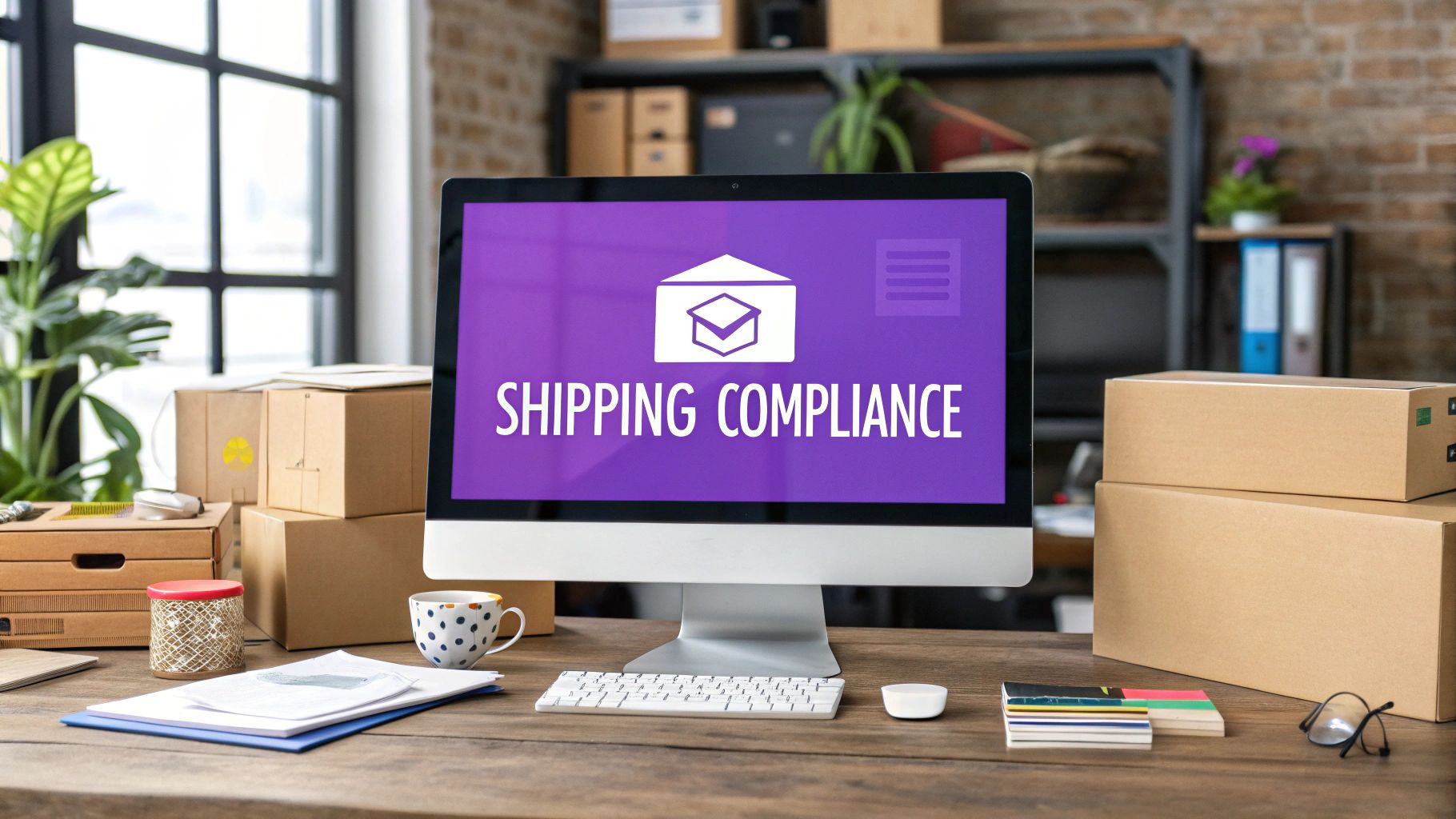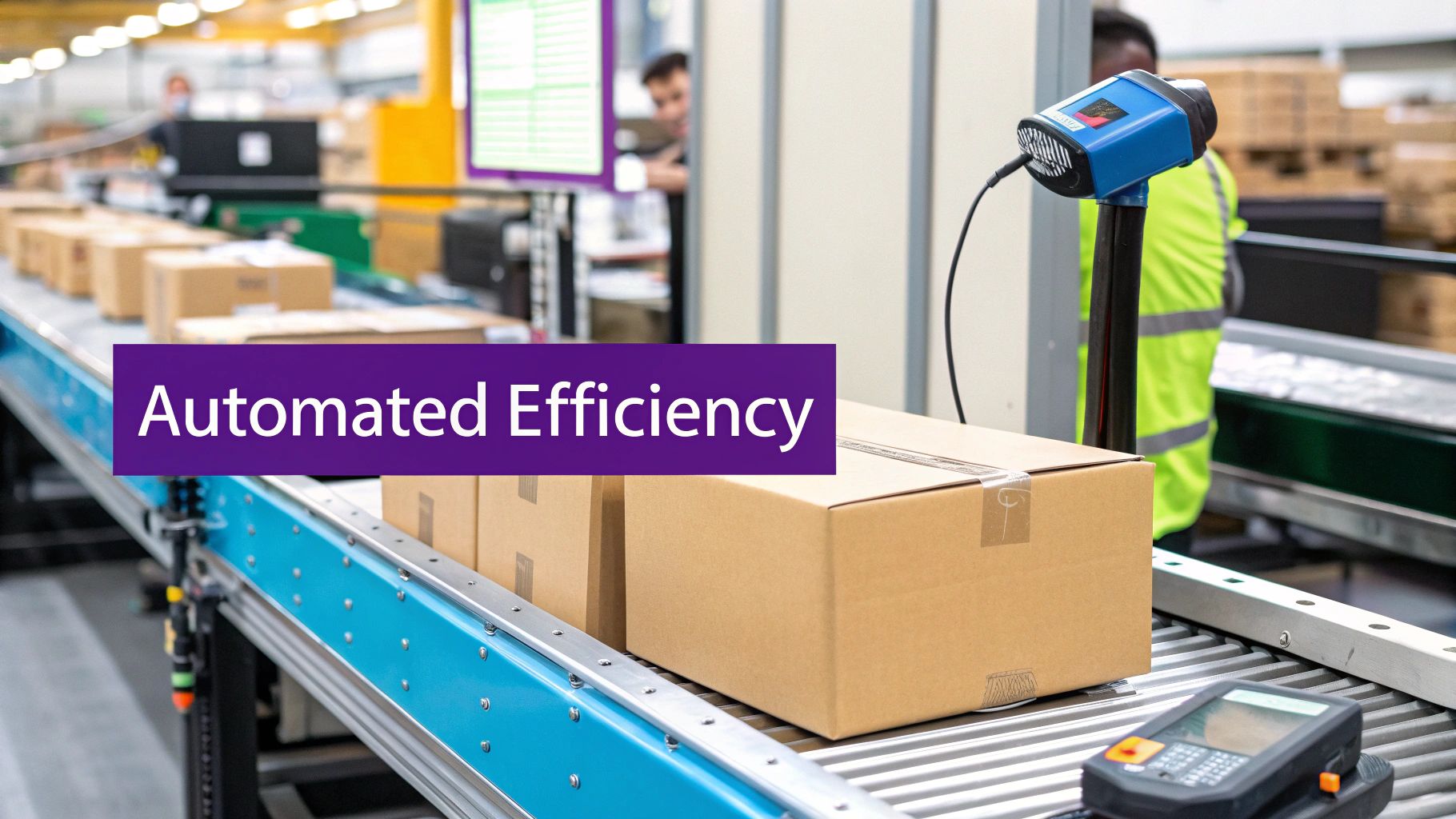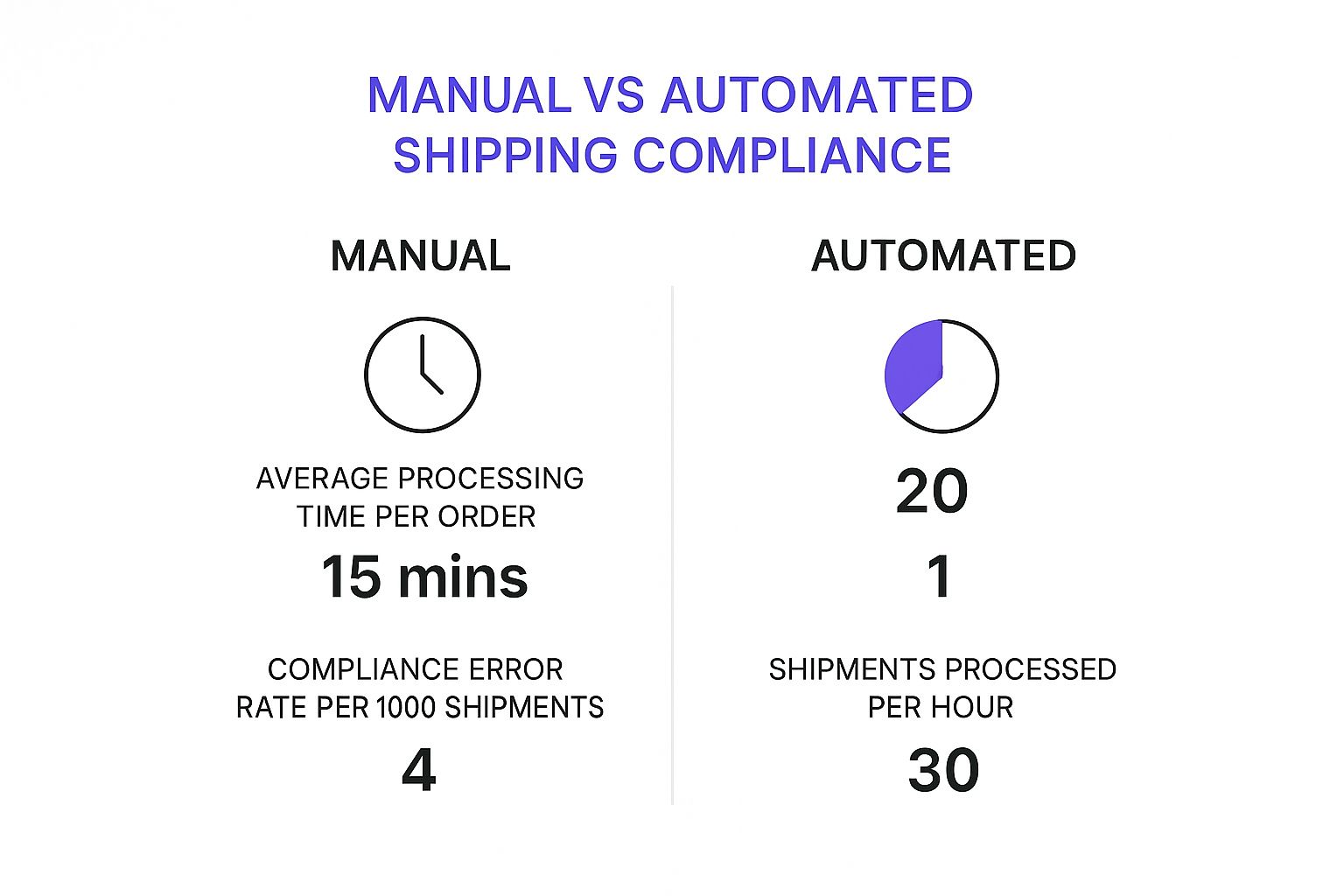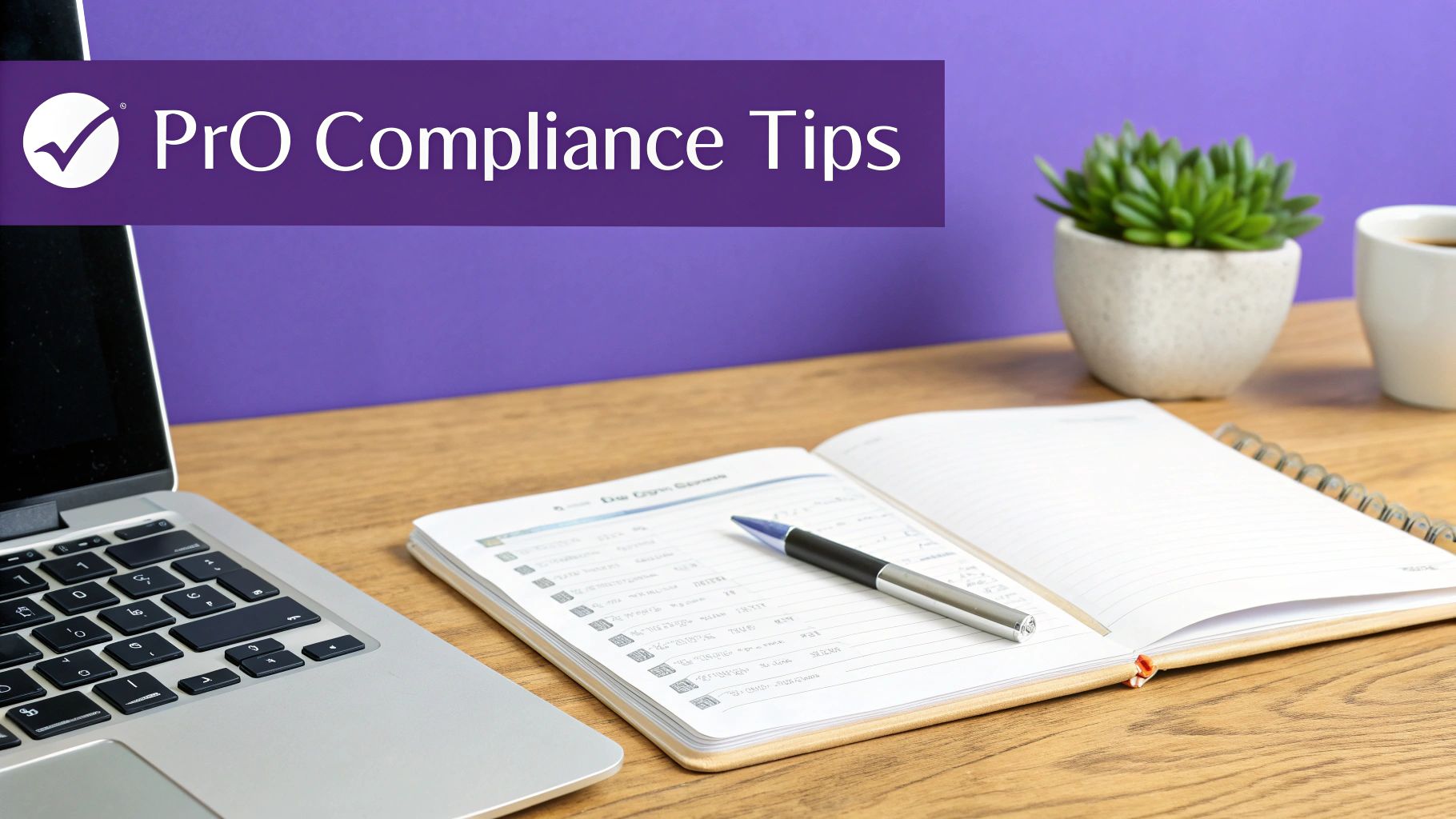
Automated Shipping Compliance for WooCommerce Stores: Simplify & Grow
Learn how Automated Shipping Compliance for WooCommerce Stores can streamline rules, customs, and fulfillment—prevent errors and boost your store’s growth.
Cody Y.
Updated on Sep 3, 2025
Automated shipping compliance is all about using software to enforce your shipping rules automatically. For a WooCommerce store, this means preventing orders that break carrier regulations or legal restrictions right at the checkout. It's a critical safety net for avoiding expensive fines, returned packages, and unhappy customers, especially if you sell regulated goods or ship internationally.
Why Manual Shipping Puts Your WooCommerce Store at Risk
Shipping products from a WooCommerce store isn't just about packing a box anymore. Today, you're navigating a maze of international trade rules, carrier requirements, and high customer expectations. Sticking with manual shipping management isn't just inefficient—it's a massive business risk.
Manual processes are a breeding ground for human error, and a single mistake can create a domino effect of problems. Overlooking a state-specific product restriction or miscalculating a customs duty isn't a minor slip-up. These errors translate directly into lost revenue and operational chaos.
The Real-World Consequences of Non-Compliance
The financial hit from non-compliance is often immediate and painful. Fines from carriers or government agencies for bad paperwork or shipping restricted items can be substantial. On top of that, the operational costs of returned packages pile up fast, chipping away at your profit margins with every box that comes back to your warehouse.
Think about these common scenarios that manual checks miss all the time:
- Customs Delays: An incorrect Harmonized System (HS) code can leave a package stuck in customs for weeks. The result? Angry customers and a high chance of cancelled orders.
- Unexpected Fines: Shipping a product with a lithium battery using the wrong service can lead to thousands of dollars in carrier fines.
- Damaged Reputation: When you consistently fail to deliver on time because of compliance hold-ups, you erode customer trust. And winning that back is incredibly difficult.
Looking at the bigger picture, a practical guide to automation for small businesses shows how streamlining operations goes far beyond just shipping. Automation is a strategic move to build a more resilient and scalable business.
For many store owners, the "we'll handle it as it comes" approach works right up until the moment it catastrophically doesn't. A single compliance failure on a large B2B order can easily wipe out an entire month's profit.
Regulatory Shifts Demand Automation
Recent regulatory changes have made automated systems less of a "nice-to-have" and more of an absolute necessity.
Take the end of the U.S. de minimis exemption in 2022. This was a huge shift. Previously, tons of international shipments valued under $800 sailed into the US duty-free with almost no paperwork. Now, every single shipment, no matter the value, needs detailed customs documentation. This includes a 10-digit HTS code for courier shipments.
You can read more about these US tariff and shipping policy changes on WooCommerce.com. This one change alone exponentially increased the compliance burden on international sellers, making manual data entry at scale a recipe for disaster.
Choosing Your WooCommerce Compliance Plugin
Alright, let's get practical. The first real step toward automating your shipping compliance is picking the right tool for the job. You need a WooCommerce plugin that acts like a smart gatekeeper, enforcing all your shipping rules before an order can even be placed.
Don't get bogged down by plugins that just offer basic shipping zones. You're looking for something with a powerful, conditional logic engine at its core. Can it restrict shipping based on a product category, a specific user role, a list of zip codes, or even the total weight of the cart? That level of granular control isn't just a nice-to-have; for stores selling regulated or complex products, it's non-negotiable.

Key Features to Look For
When you're comparing plugins, you need a way to cut through the marketing fluff and see what actually matters for your store. A simple checklist of core features is the best way to do that.
Here's what I always look for:
- Rule-Based Logic: The plugin absolutely must let you build rules using multiple conditions. Think combinations of destination (state, city, zip code), product attributes (category, tag, weight), and what’s in the cart.
- Carrier Integration: Does it play nice with your primary carriers? You need to know that the rules you set in WooCommerce actually align with the services and restrictions from carriers like FedEx or UPS.
- Real-Time Validation: The check needs to happen instantly at checkout. If a customer's order is non-compliant, they need immediate, clear feedback. This is crucial for preventing checkout friction and saving would-be abandoned carts.
- Performance Optimization: A poorly coded plugin can bring your entire site to a crawl. I always check reviews and developer documentation for any mention of performance, especially how it handles checkouts during high-traffic sales.
Installation and Pre-Setup Checks
Once you've landed on a solid plugin like Ship Restrict, the installation itself is a breeze. Inside your WordPress dashboard, you just navigate to Plugins > Add New, upload the plugin's .zip file, and hit "Activate." Simple.
But hold on. Before you even click "buy" on any plugin, do yourself a favor and run these quick pre-setup checks. It’ll save you a world of headaches later.
Pro Tip: Always check a plugin’s "Tested up to" WordPress and WooCommerce version numbers on its product page. I've seen countless issues stem from trying to run a new plugin on an old, outdated store. It's a leading cause of compatibility problems and a huge security risk.
Take five minutes to confirm your store meets the minimum requirements:
- WordPress Version: Is your WordPress core up to date?
- WooCommerce Version: Is your WooCommerce plugin current?
- PHP Version: Are you running a supported, modern version of PHP on your server?
These checks are quick but foundational. Getting this right makes the entire setup and configuration process ten times smoother. For a deeper dive into why these technical details are so important, you can learn more about WooCommerce compliance strategies and best practices.
Setting Up Foundational Shipping Rules and Restrictions
Alright, you've got your compliance plugin installed. Now for the fun part: building the intelligent framework that will automate your shipping compliance 24/7. This is where we translate all those operational needs and legal requirements into a set of digital rules that do the heavy lifting for you.
The goal here isn't just to block orders. It's about guiding customers to a successful, compliant checkout. This process kicks off by creating your foundational shipping rules, which act as the first line of defense against costly mistakes.

Restricting by Product Category
One of the most powerful and common starting points is building rules based on product categories. This approach is a lifesaver for stores with diverse inventories where different items have their own unique shipping needs.
Let's say you sell both standard apparel and a line of aerosol-based fabric care products. Your apparel can ship anywhere, no problem. But those aerosols? They're classified as hazardous materials (HAZMAT) and are a big no-go for air freight.
Instead of sweating over every order, you can create a rule that automatically hides all air shipping options—like "Next Day Air"—whenever a product from the "Fabric Care" category is in the cart. This instantly prevents a non-compliant order and shields you from significant carrier fines. Of course, a critical part of this is mastering your shipping cost calculator to make sure the rates for the available methods are spot-on.
This level of control is essential. Research shows that unexpected shipping restrictions are a major reason people abandon their carts. By proactively showing only valid options, you create a much smoother customer experience while keeping your operations compliant.
Creating Rules Based on Cart Contents
Beyond broad categories, you’ll often need to drill down and set rules for specific items or even combinations of products. This is where automated compliance truly shines, handling complex scenarios that are frankly impossible to manage by hand.
Imagine a store that sells medical supplies. You might offer sterile surgical kits that demand cold-chain shipping, alongside standard items like bandages that don’t. A powerful plugin lets you create a rule that says, "If the cart contains 'Sterile Kit X,' then only show 'Cold Chain Express' shipping." Simple as that.
This logic is incredibly flexible. You can build rules based on all sorts of conditions:
- Specific Products: Is a particular high-value item in the cart? Restrict shipping to insured methods only.
- Item Count: Does the cart contain more than 10 items? Maybe you hide flat-rate options and only show calculated shipping.
- Total Weight: Is the cart's total weight over 50 lbs? You can restrict shipping to freight carriers.
These cart-based conditions are the building blocks of a truly automated system. For a more detailed walkthrough, you can learn exactly how to hide shipping methods based on cart contents in WooCommerce and start handling these scenarios yourself.
Getting hands-on with this kind of configuration ensures your store stops non-compliant orders before they ever hit your fulfillment queue. This proactive approach is the core of automated compliance, saving you countless hours and preventing expensive shipping errors.
Automating Cross-Border Shipping and Customs
Opening your WooCommerce store to international customers is a huge opportunity, but it also throws a wrench into your fulfillment process: customs. Managing this stuff manually is more than just a time-sink. It’s a recipe for held packages, surprise fees, and unhappy customers from around the globe. True automated shipping compliance turns that potential nightmare into just another smooth part of your workflow.
The real magic happens when you configure your system to intelligently handle rules based on location. A solid compliance plugin lets you go way beyond just blocking entire countries. You can get granular, setting up rules for specific states, provinces, or even down to a range of postal codes. This is exactly what you need to navigate regional trade restrictions, embargoes, and those pesky carrier-specific dead zones.
Navigating Regional Trade Restrictions
Let's imagine you sell artisanal food products. You can ship to most of Europe, but one of your key products contains an ingredient that Italy prohibits. Instead of trying to catch these orders manually or messing with a complicated spreadsheet, you set a simple rule: "If the destination is Italy AND the cart contains 'Product X,' then hide all shipping methods."
Done. That non-compliant order can't even be placed. You've saved yourself the headache of canceling an order and protected the customer relationship. You can apply this same logic to all sorts of scenarios:
- Embargoed Nations: Block all shipments to countries under trade sanctions.
- State-Level Laws: Stop the sale of certain electronic parts to California because of specific regulations.
- Carrier Dead Zones: Hide specific carriers for remote postal codes they don’t serve well.
This is where the efficiency gains really stack up, as this visual breakdown shows.

The data speaks for itself—a massive drop in processing time and errors. This allows stores to handle a much higher volume of international orders without having to hire more people just to manage the paperwork.
When you look at the day-to-day tasks involved, the difference between a manual and automated approach becomes crystal clear.
Manual vs Automated International Compliance Tasks
| Compliance Task | Manual Process | Automated Process |
|---|---|---|
| Location Checks | Manually checking each order's address against a spreadsheet of restricted areas. | Rules automatically block or allow shipping methods at checkout based on the customer's address. |
| Product Restrictions | Cross-referencing items in the cart with a list of prohibited goods for the destination country. | Product-specific rules prevent checkout if a restricted item is in the cart for a specific location. |
| Customs Forms | Manually typing HS codes, product descriptions, and values onto customs declaration forms. | Forms are auto-populated with product-level HS codes and order data when a label is created. |
| Tariff Calculation | Using external websites or charts to estimate duties and taxes, then communicating them to the customer. | Integrations provide real-time duty and tax calculations directly in the cart or at checkout. |
| Carrier Selection | Guessing which carrier is best for a destination or manually looking up service availability. | The system automatically hides carriers that don't service a specific postal code or country. |
This table highlights just how much administrative burden a good compliance plugin can lift from your team, freeing them up to focus on growing the business instead of getting bogged down in red tape.
Automating Customs Documentation
Maybe the single biggest headache in cross-border e-commerce is customs documentation. Every single international package needs accurate paperwork, especially the Harmonized System (HS) codes used to classify goods for customs officials. Getting this wrong is the #1 reason packages get stuck in customs.
Modern compliance plugins solve this by integrating directly with carrier APIs. When your WooCommerce shipping plugin retrieves real-time rates from carriers like USPS or DHL, it can do more than just generate a label—it can populate the customs forms, too. For international shipments, getting the duties and taxes right is critical, and using a tariff cost estimator can make this much simpler.
By assigning HS codes at the product level right inside WooCommerce, the plugin can automatically pull that data and place it correctly on the electronic customs declaration when you generate a shipping label. This completely gets rid of manual data entry and almost eliminates the risk of human error.
This level of automation is a game-changer, especially when working with global giants like DHL, which moves around 1.8 billion packages every year across more than 220 countries. Their entire network runs on accurate digital data to keep things moving. By ensuring every label is perfect from the start, you give your international customers the seamless experience they expect and keep your packages flying through customs.
Integrating Automated Insurance to Manage Risk
True automated shipping compliance goes way beyond just following carrier rules and regulations. It’s also about actively protecting your business from financial risk. Every single package you ship is an asset, and without the right protection, you're just one lost or damaged shipment away from a direct hit to your profits. By integrating automated shipping insurance, you turn it from a last-minute chore into a core part of your risk management strategy.
This means setting up smart rules that automatically apply insurance based on triggers you define. Instead of your team having to remember which orders need coverage, the system just handles it. This not only protects your revenue but also helps you meet compliance requirements for high-value products or specific carrier services that require insurance.

Configuring Insurance Triggers for High-Value Orders
One of the most common—and effective—strategies is tying insurance directly to the order total. It's simple: you can set a rule to automatically add insurance to any order that goes over a certain amount, say $100. This makes sure your most expensive shipments are always protected, with zero manual work for your fulfillment team.
Let's imagine you sell consumer electronics. A customer orders a new camera for $800. With an automated rule in place, your system instantly adds the correct insurance coverage as soon as the shipping label is generated. This protects you from theft, loss, or damage in transit, turning what could have been a major financial loss into a simple, manageable claim.
Automated insurance isn't just a shield for your business; it builds customer trust. When shoppers know their expensive orders are fully insured, it gives them more confidence in your store and can reduce hesitation when they're about to click "buy" on a high-ticket item.
Automating Coverage for High-Risk Shipments
Beyond just the price tag, you can build rules based on other risk factors. This is incredibly useful for stores that ship fragile products, items that need special handling, or packages going to destinations with a history of shipping problems.
Here are a few practical examples of how you could set up risk-based insurance rules:
- By Product Category: Automatically insure every order that contains products from your "Glassware" or "Antique Collectibles" categories.
- By Destination: Add mandatory insurance for all international orders or for shipments to specific regions known for logistical headaches.
- By Carrier Service: If a customer picks a budget shipping option, you could add insurance to offset the slightly higher risk that sometimes comes with non-premium services.
These rules become absolutely critical when you're dealing with sensitive goods. For example, our guide on pharmaceutical shipping limitations in WooCommerce shows just how vital insurance and strict compliance are for protecting both your products and your business. Platforms like LateShipment.com have even reported claims success rates around 99% by automating this process, proving just how powerful it can be. You can learn more about their WooCommerce shipping insurance solutions and how they automate risk management.
Common Questions About WooCommerce Shipping Automation
<iframe width="100%" style="aspect-ratio: 16 / 9;" src="https://www.youtube.com/embed/eH5IVD_DEFY" frameborder="0" allow="autoplay; encrypted-media" allowfullscreen></iframe>Switching from manual checks to an automated shipping system is a big step, and it naturally brings up some questions. It's smart to wonder how the software handles those tricky, real-world scenarios you deal with every day.
Let's walk through some of the most common questions we hear from store owners. Getting these details right from the start is key to a smooth, compliant operation.
Handling Mixed Carts with Restricted Items
One of the first things people ask is: what happens when a customer has both restricted and non-restricted items in their cart? This is a classic "mixed cart" problem that can completely derail a manual fulfillment process.
A properly configured compliance plugin like Ship Restrict handles this without breaking a sweat. It looks at the entire cart and applies the strictest rule needed. It will only show shipping methods that are compliant for all items in the order.
Imagine a cart with a t-shirt (no restrictions) and an aerosol can (can't ship by air). The system will automatically hide options like "Next Day Air" at checkout. Your customer only sees the ground options that work for their entire order, preventing a compliance headache and keeping the checkout experience clean.
Managing Complex Tax Regulations
Another big question is whether a shipping plugin can also handle things like EU VAT. While shipping compliance plugins are experts at enforcing carrier rules, customs, and transit restrictions, they are highly specialized tools.
It's crucial to understand the distinction: shipping compliance plugins manage the physical movement of goods, while tax plugins manage the financial transaction. Trying to find one tool that does both perfectly is often a recipe for compromise.
The best practice is to let specialized tools do what they do best. Your shipping plugin ensures the right shipping methods are available, and a dedicated tax plugin like TaxJar or Avalara calculates the correct VAT or sales tax. This approach gives you maximum accuracy on both fronts.
Keeping Your Shipping Rules Updated
Compliance isn't a one-and-done setup. Things change. After you get your rules configured, it's a good idea to review them quarterly or whenever a major carrier like UPS or FedEx announces policy changes.
You’ll also need to revisit your rules in a few other situations:
- You add new product lines: A new product might have unique shipping requirements you haven't accounted for yet.
- You expand to new countries: Every new market brings its own set of regulations and carrier limitations.
Staying on top of these updates ensures your automated system remains a reliable part of your business.
Impact on Checkout Speed
Finally, will all this automation slow down your checkout? A well-built plugin shouldn't create any noticeable lag. Quality tools are optimized for performance, running rule checks and API calls in the background with incredible speed.
When you're evaluating a plugin, look for user reviews that specifically mention performance. You want something built to handle the demands of a busy e-commerce store without causing friction for your customers.
Ready to eliminate shipping mistakes and save hours every week? The Ship Restrict plugin provides the powerful, automated rule enforcement your WooCommerce store needs to stay compliant and grow with confidence. Get Ship Restrict today!

Cody Yurk
Founder and Lead Developer of ShipRestrict, helping e-commerce businesses navigate complex shipping regulations for regulated products. Ecommerce store owner turned developer.